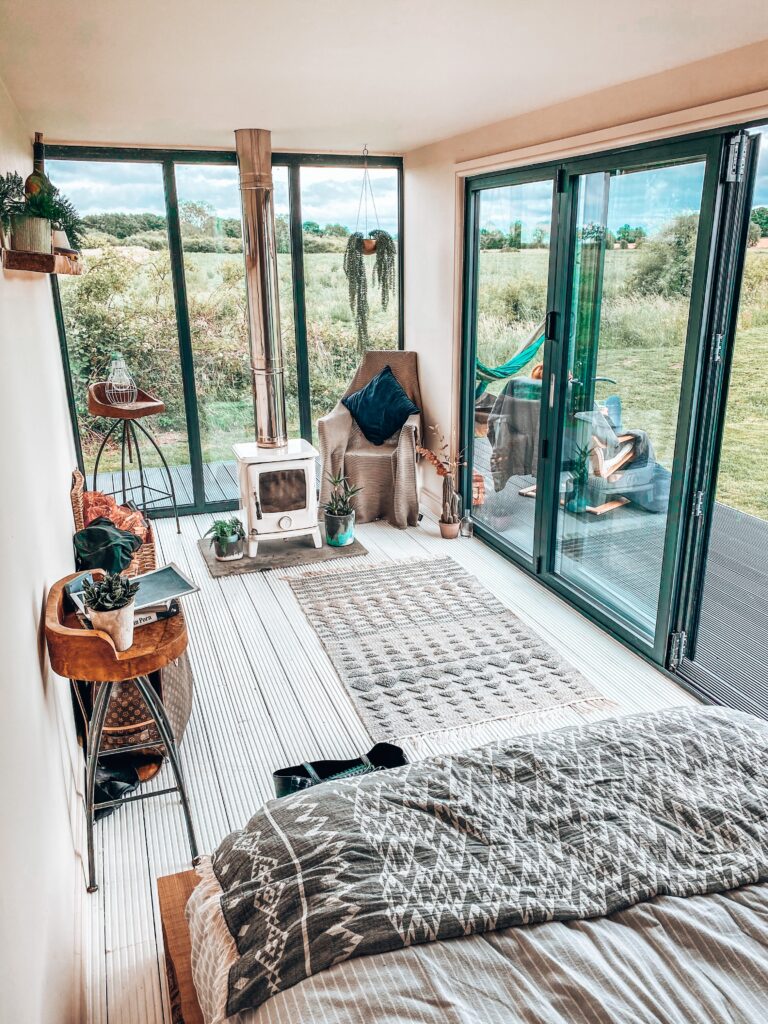Edited and Packaged by Shyana Fisher

Dr. Maria Saxton has a fascination for tiny homes. She earned her Ph.D. in Environmental Planning and Design from Virginia Tech. For her doctoral research, she investigated the ecological footprint of people who downsized to tiny homes. In her work, Saxton explains how downsizing is a process and not something to be done overnight. Her research shows that while many people choose to downsize primarily for financial reasons, they end up embracing a minimalist lifestyle to meet their new reality. We sat down with Dr. Saxton to ask her a few questions about the insurgence of tiny houses and their footprint on the environment.
Q: What inspired your research and your focus on tiny homes?
A: I’ve always been environmentally conscious, and is therefore one of the reasons why I went into this field. There has been a growing interest in alternative living over the past decade. The media has encouraged this growing trend of living tiny as being better for the environment. I wanted to develop this study to provide data and evidence on how downsizing can impact the environment.
Q: What parameters did you include in your measurement of finding an individual’s ecological footprint?
A: I purely relied on the Global Footprint Network and everything they look for, such as how often does one eat animal-based products, the type of home one lives in, etc. I did discover that their footprint calculator, as well as a lot of footprint calculators, didn’t cover everything that relates to tiny home living. For instance, water conservation was not covered at all in the ecological footprint calculator that I used. I found that a lot of the occupants in my study were making a really conscious effort to reduce their water use which would further impact the size of their ecological footprint.
The tiny home trend has been on the rise in the United States over the last ten years. Television shows, such as Tiny House Nation, and blogs have been furthering the interest in downsizing. The U.S. Department of Housing and Urban Development has seen a subtle decline in the average square footage of privately-owned homes. Tiny homes cost between $30,000 to $100,000, making them an alternative option in affordable living. This is one of the primary aspects that has supported the growing movement; however, things such as parking, insurance, land or leasing fees, repairs and utilities all require further research for anyone interested in becoming a tiny homeowner.
Q: What did you discover about why people choose to downsize, and how did their lives change after their transition to living tiny?
A: The number one reason was affordability. My study included 80 participants across the United States who have lived in a tiny home for at least a year. On average, 45% of participants showed a reduction in their ecological footprint after downsizing. The concept of a minimalist lifestyle allows individuals to simplify their lives and their belongings. Many people do also choose to downsize for the sole purpose of decreasing their environmental impact.
Q: What are some of the challenges that come with downsizing?
A: Many of the participants in my study lived in tiny homes that were occupied by one to two people. Some of the challenges they faced had to do with the fact they had less space to store their stuff. Downsizing comes with having to give up a lot of your material things in order to fit in a space that is 400 square feet or less. Many people struggle with storing garbage and recyclables because they simply do not have space to recycle properly. When it comes to families who choose to downsize, having an aging child can be difficult because they need their own space and may require a little extra privacy as they go through their stages of development. These are just a few of the challenges that can come with downsizing to a tiny home, but it also is based on the type of person going into this process.

Q: How has the tiny home community been affected by the COVID-19 pandemic?
A: Amidst the Coronavirus, I have seen a lot more buzz in the tiny home community. Many people are reaffirming their decisions to downsize to a tiny home. People who have been thinking about downsizing over the past five years or so are now reconsidering the idea because they want to have the opportunity to essentially have more resilient housing. They want to be able to build and own their homes outright, or they would like the opportunity to be able to move their homes to a more rural area to seclude themselves from things like this. Over the past two months I have definitely seen quite an upward trend in the conversation of downsizing.
A lot of people romanticize the idea of tiny homes and it is great in so many ways, but it is not for everybody.
Dr. Maria Saxton
Q: What advice do you have for anyone interested in downsizing?
A: You want to take your time to downsize because it is a big step to take to living tiny. It is important to do some research. People who tested out what it is like to stay in a tiny home for about a month or so were much more prepared than the people who transitioned outright. A lot of people romanticize the idea of tiny homes and it is great in so many ways, but it is not for everybody.
Dr. Saxton founded NANO — Tiny Life Innovators in 2018. The company’s priority is to provide consulting and advertising services for the tiny home community. With a focus on creating sustainable and affordable designs, she is able to continue making strides in her research in order to develop solutions for individuals that wish to join the minimalist movement.
Interested in more FEATURES stories? Check out:
Nadine Cafaro addresses SUNY New Paltz’s disparities in resource distribution by the area of study
Gillian Hamilton explores the benefits and stipulations that come alongside tiny home living through a Q&A with researcher Dr. Maria Saxon.
Jessica Barr dives into the dangers of cyber stalking and how to handle it.
Joseph Juste examines the measures taken by local food pantries and meal services to provide services while staying safe during a pandemic.
Max Freebern describes the story of two homeless women in Ulster County struggling to find housing during the pandemic.
Taylor Dowd provides insight on hunger relief organizations in New Paltz and Ulster and how they’re managing during the pandemic.
Emma Cariello explores the niche appeal the A24 film studio brings to young moviegoers and what makes their works so iconic.
Ericka Francois sits down with John Wayne Gacy rape survivor and domestic and sexual abuse advocate Patrick Dati.
